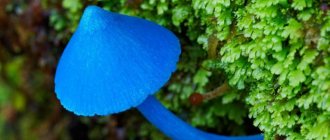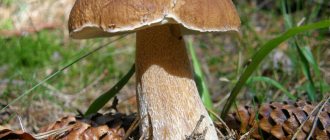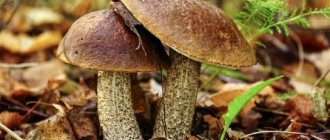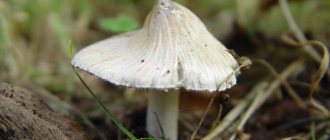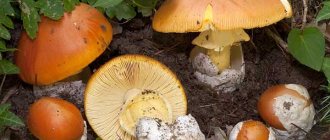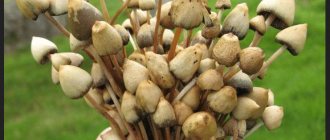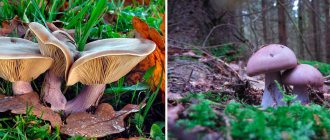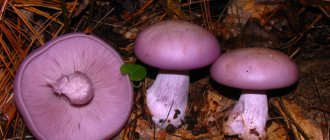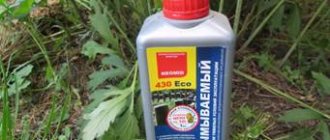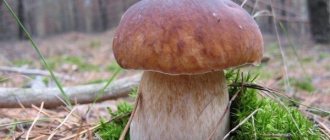From spring to autumn, cavalcades of yellow-orange caps can be found on trees in the forest. This grows the woody Chicken Mushroom, whose flesh tastes like chicken. This article talks about the features of this mushroom, the necessary precautions when preparing it, and its beneficial properties.
Chicken mushroom
All summer in deciduous forests you can find a very funny bright yellow-orange mushroom on tree trunks. In his youth, he generally looks like a drop of yellow resin that has broken through the bark and frozen on it. A mature mushroom looks like a whole battery of bright, sticky flying saucers stuck to the bark - it is simply impossible not to notice such a miracle in the forest.
This is the Chicken Mushroom, Laetiporus sulphúreus or Sulfur-Yellow Polypore. Refers to conditionally edible mushrooms
Appearance
Chicken Mushroom: appearance
Initially, the Chicken Mushroom looks like a large influx of viscous liquid, yellow-orange in color, breaking through the bark; with age, the tinder fungus takes the form of an enfilade of pseudo-caps fused together like a fan, usually sitting on one base, less often single. The diameter of the caps ranges from 10 to 40 cm, their edges are wavy and divided into separate lobes. The thickness of the mushroom near the tree trunk can reach 7 cm, and the weight of the entire fruiting body sometimes reaches 10 kg. The top of the mushroom is often covered with a light yellow-cream fluff.
Tubular-type plates with small or jagged pores.
The pulp is yellowish-white, brittle and juicy, soft and sour in taste. Young specimens have a pleasant smell of freshness with a lemon tint, while older specimens have a stale smell, and the flesh itself becomes woody and pale.
The color of the Chicken Mushroom changes with age from pale yellow to orange or pinkish orange, often the edges of the caps are lighter than the middle.
With cheese
Chicken breast with mushrooms and cheese sauce, again cooked right in the pan according to this recipe, always turns out very tasty. It can be eaten as a separate dish or served with your favorite side dish.
Cooking method:
- Wash 300 grams of champignons well under running water, remove the skin from the caps and cut into small slices.
- Wash 600 grams of chicken fillet and chop into small cubes. Grate 150 grams of hard cheese on a coarse grater.
- Heat a deep frying pan over low heat, pour in vegetable oil and add mushrooms. Fry until all the moisture that comes out of them has evaporated.
- Add the chopped chicken fillet and fry for another 5-7 minutes until golden brown.
- Add salt and ground black pepper to taste, pour in 500 ml of 20% cream, mix and simmer over low heat.
- As soon as the sauce thickens and boils, add the grated cheese, stir and remove from heat. The dish can be served separately or with your favorite side dish or fresh vegetable salad.
Where does Chicken Mushroom grow?
Polypore is a parasitic fungus; it destroys the tree on which it grows, causing red-brown destructive stem rot and red-brown prismatic core rot, affecting primarily the core of the tree.
The Chicken Mushroom's favorite victims are poplar, oak, willow, linden, cedar, birch, pine, chestnut, walnut, maple, larch and various fruit trees. There is a special subspecies of the sulfur-yellow Polypore, which lives on coniferous trees and is not recommended for consumption. It bears fruit from mid-May to autumn, and the peak of its activity occurs in May - June. Chicken Mushroom is often found growing at a respectable height from the ground, so be sure to look up when looking for it.
Chicken mushroom on the tree
Alternative names
Compared to other representatives of the genus and family Arachnidaceae, the chicken mushrooms or, scientifically, the annular cap, belong to the category of edible mushrooms. The nondescript appearance did not affect the taste and captivating mushroom aroma, and was loved by many mushroom pickers. Popularly, the mushroom has different names, but the most popular ones, which can be heard in discussions on forums and social media groups, include the following:
- mushroom Cockerel or Chicken;
- Swampy;
- white marshweed;
- Turk mushroom;
- cap;
- Rosites dull;
- gray sandpiper;
- greenfinch (unknowingly);
- green grass;
- a gray row, although it is not one.
Important!
The taste of chicken is felt not only in one mushroom of the Arachnoidaceae family. An unusual feature is also observed in the Umbrella of the Champignonaceae genus. Popularly known as "Pop", it has an unusual appearance, comparable to a fly agaric. Unknowingly, the fruits are often kicked, classifying the edible variety as poisonous.
The mushroom is little known among mushroom pickers, who collect only popular varieties of the mushroom world. However, according to statistics, chicken mushrooms sprout over large areas and it is almost impossible not to encounter them. It is enough to know the distinctive features to diversify the daily menu, increasing the harvest by two or three times.
How to distinguish a young Chicken Mushroom from an old one
The sulfur-yellow tinder fungus is edible at any age, but the old fruits are too hard and taste like a chewed cork - there is little pleasure in this. But in its youth, the pulp of this mushroom is a real delicacy, so it is important to be able to distinguish a young mushroom from an old one:
- Young sulfur-yellow Tinder mushrooms have a more saturated and bright color, while old mushrooms on top seem to fade and become more faded.
- Young ones are soft and moist to the touch, the plates under their caps actively secrete yellowish droplets. Old ones are dry and hard.
- You can carefully peel and bite the flesh - the young mushroom has a soft and delicate taste, while the old ones have a corky taste and a pronounced sourness.
Amazing chicken with mushrooms - step by step photo recipe
In this recipe you will learn how to deliciously cook chicken with mushrooms in the oven. This dish can be safely served for a holiday. This recipe is very similar to French meat, but there are still differences. Try it and you will definitely be satisfied.
Your mark:
Cooking time: 35 minutes
Quantity: 4 servings
Medicinal properties of Chicken mushroom
Chicken Mushroom contains antibiotics that successfully fight staphylococcus. There are medicines that use a squeeze of tinder fungus. It is also used in anti-tuberculosis agents and laxatives.
About 70% of the mushroom pulp consists of resinous substances, which are beneficial for the lungs, gall bladder and liver. It contains glucan compounds that bind heavy metal ions, polysaccharides that help reduce the volume of malignant tumors, acids that support the endocrine system, various trace elements and lipids that contribute to the overall strengthening of the body. LSL-lecithin contained in tinder fungus is used to combat thrombosis. The mycelium of the polypore contains substances that have an antimicrobial effect, and it is used to fight infections, including in the genitourinary area.
In Japan, sulfur-yellow polypore is used as a means of weight loss - it helps produce an enzyme that breaks down fat.
In folk medicine, decoctions made from it are usually used.
Farmers make an infusion with this mushroom to water their tomatoes and potatoes - this helps against the spread of late blight.
You can make a simple restorative tincture from tinder:
- Pour 40 gr. peeled mushroom with half a liter of 20% alcohol.
- Leave for 3 days in a dark place.
- Take a tablespoon 3 times a day before meals. The course of treatment is 10 days. Store the tincture in the refrigerator.
Raising chickens (cockerels) artificially at home + photo
In Europe, the cultivation of the annular cap has been successfully carried out for many years. Excellent chicken taste, mushroom aroma and high value of the product equate the mushroom to the Champignon family. However, artificial germination at home of the genus Arachnidaceae requires simpler instructions and minimal care.
Growing on stumps
To carry out cultivation on stumps, they use cuttings of deciduous trees that have been saturated with melt water over the winter. In the fall, the material is prepared and placed in the lowlands of the area where the most snow accumulates, and in the spring, when the sun warms up to 5-7 degrees Celsius, they get to work.
Step-by-step instruction:
1) Spores collected last year are soaked in warm water using a bag made of natural fabric to prevent loss of seed material. The procedure lasts from 3 to 12 hours, depending on the preliminary storage method.
2) Using a saw, make deep cuts on the top of the stumps. Spores are hammered into the holes and sprinkled with sawdust, lightly tamping with clean fingers. To avoid the entry of pathogenic microorganisms, work is carried out with gloves or after washing your hands in soapy water.
An alternative to notching will be holes drilled using a drill. According to reviews from gardeners, the method is highly effective, but physically difficult and takes a lot of time.
3) Upon completion, the stumps are placed in a vertical position in the direction of tree growth and covered with earth. Horizontal arrangement is also allowed, but only if there are horizontal cuts.
4) Using a watering can, in order not to wash away the spores hidden under the sawdust, the stumps are shed generously, repeating the procedure 1-2 times a week, depending on the climate of the region and the prevailing weather.
Important!
When choosing a tree for cultivation, it is better to give preference to deciduous species: birch, maple, willow, oak. For example, oak logs will last longer and turn into dust an order of magnitude longer than other trees.
Fruiting time is from 4 to 7 years. In the first and last year, the harvest is reduced by half.
Propagation of chicken mushrooms from rotten stumps
If Cockerel mushrooms have been sprouting on the site for many years and the stumps gradually began to turn into dust, wood will allow you to propagate your favorite mushrooms. Wide holes are made in the new planting material and pieces of infected wood are placed inside, filling the cracks with sawdust.
The method is quite simple, although controversial in terms of service time. As practice shows, the shelf life is reduced by several years due to extensive removal of part of the trunk.
Important!
The option involves the use of drip irrigation instead of classic. With its help, the fruiting period can be increased by 1-2 years.
Growing on wood waste
This growing method is chosen mainly in two cases:
1) in the absence of a summer cottage or personal plot, but the presence of a basement or garage;
2) as a growing technology for sale, to collect mushrooms at any time of the year, maintaining the necessary humidity and air temperature;
Step-by-step instruction:
1) sawdust with shavings or wood chips are sterilized in the boiler, adding a little water so that the material does not stick to the metal walls. From time to time the base for infection is stirred;
2) as soon as the base is ready, without waiting for it to cool, add starch and oatmeal (10 g per 1 kg) and mix well;
3) while the mixture is cooling, sterilize three-liter jars or prepare clean bags, such as those used for growing oyster mushrooms;
4) the material is placed in jars and left to cool completely for 1-2 hours;
5) after the time has elapsed, pour out the spores soaked in water and mix thoroughly.
Important!
An analogue of cans can be plastic bags, wooden and plastic boxes, and deep pallets.
Growing on wooden chocks
Another common growing option is planting material in the form of deciduous tree trimmings. Its length should reach from 35 to 45 cm, and its diameter should be at least 14-17 cm. As in the case of preparing logs, logs are laid out in the lowlands of the site before winter so that the wood can be saturated with melt water until mid-spring, preparing for cultivation.
Work is carried out with the onset of warm weather to promote accelerated infection of wood. The optimal temperature is 12-14 degrees Celsius.
The implementation of the technology is identical to the method of cultivating logs. Chicken mushrooms take root better when infecting deep layers using the method of notching or drill holes. Upon completion of the instructions, the lumps are laid horizontally and spilled with settled water collected in a watering can.
Fruiting after cultivation in a simplified way is reduced, approximately up to 3 years.
Carefully!!!
Polypore absorbs various chemicals very well, so you should not collect it near city limits or large enterprises. The older the fruiting body is, the more rubbish can accumulate in it - another reason to avoid older specimens.
The sulfur-yellow tinder has twins, but it is not at all difficult to distinguish them either by color or by place of growth.
First, you should be wary of Laetiporus conifericola , a species of polypore that grows on coniferous trees. You won’t necessarily get poisoned by it, but we strongly advise against taking risks.
Laetiporus conifericola
There are also:
Meripilus giganteus
- Meripilus giganteus - it is very similar to the tinder fungus, but grows mainly on beech and oak. It differs in color - it goes more into brown shades, and in size and weight it can exceed the tinder fungus. Fruit bodies weighing up to 25 kg are known. It is just as edible when young and after preliminary washing and boiling. The only peculiarity is that it cannot be pickled; the mushroom does not tolerate this procedure.
Climacodon Northern Climacodon Septentrionalis or Northern Hedgehog
- Climacodon Northern Climacodon Septentrionalis or Northern Hedgehog. It is inedible, but it is impossible to confuse it with the sulfur-yellow tinder fungus - it is white, grows in peculiar “whatnots”, and the plates under its cap are in the form of thorns.
It is believed that the sulfur-yellow polypore absorbs substances from the host tree, and if it grows on a certain poisonous tree, for example, yew, then it itself may contain toxic substances. Of ordinary trees, in this sense, oak nuts pose the greatest danger. This theory has not been scientifically proven, but it also gives reasons for caution during mushroom hunting. .
Be careful when quietly hunting for tinder fungi, collect only fresh fruiting bodies, soak and boil it before eating, and then you will definitely enjoy the delicious taste of this orange woody miracle.
In which forests do they grow and how to collect them?
Chickens are the only representatives of the Rosites genus in Europe. Mushrooms love high humidity and mountain and foothill forests, reaching 2000 m above sea level. They also thrive on acidic, podzolic soils in damp, marshy areas. This is why they got one of their names – marshlanders.
They prefer to grow in symbiosis with deciduous and coniferous trees, forming mycorrhizae. You can find chicken mushrooms in both Russia and Belarus. Collection time is from July to early October.
On Russian territory
In Russia, chickens grow in the western and central regions of the European part. Their habitat:
- near the swamps of the middle and southern tundra (Murmansk coast, Karelia);
- mossy copses of the middle zone (Volga region).
You can collect cockerels in dwarf birch or blueberry. Often they can also take a liking to lingonberry thickets. Mushrooms grow in entire colonies, so you can easily fill a basket full.
In Belarus
Chickens grow everywhere in coniferous and mixed forests and near swamps of Belarus, less often in oak groves. This is one of the most popular Belarusian mushrooms. This is where the popular names for the ringed cap came from.
Harm to maitake and possible contraindications
The opinion that ram mushrooms are dangerous or not edible is erroneous, as it is based on complete ignorance of their nature and properties. They are completely safe, but in reasonable quantities. They contain quite a lot of chitin, which is why it is highly not recommended to overeat maitake.
It is worth noting that, like other members of the family, ram mushrooms serve as a good natural sponge that absorbs radionuclides and other harmful substances from the atmosphere. It is better to collect maitake in remote forested areas.
If you want to grow mushrooms, do it away from the city. A dacha plot remote from the city, or a manor somewhere in a cozy village, is best suited. This way you will be sure that the product is absolutely harmless and environmentally friendly.
In the case of using maitake mushrooms purely for medical purposes, you need to take into account some important factors that can become serious contraindications in some cases. Let us highlight the main ones:
- Ram mushrooms, or preparations based on them, are used to lower blood pressure. If you suffer from low blood pressure, you will have to give up delicious grifola dishes;
- Doctors also do not recommend eating these mushrooms during breastfeeding. This is due to the fact that all their properties and how they can affect the child’s health are not fully known;
- If you are taking medications for hypoglycemia (low blood sugar), eating sheep mushrooms is also not recommended. Poor compatibility of drugs with fungal minerals can cause unpredictable consequences;
- Some people may develop an allergic reaction to grifola. If you are not sure how your body will react to maitake, it is better not to try it.
Before using maitake-based preparations, or the mushroom itself for treatment, consult with a specialist. Although maitake has a number of unique properties and is practically not dangerous to health, a number of factors such as dosage, relevance, and individual contraindications must be taken into account.
Characteristic features of the variety
Despite their geographical widespread distribution, ringed caps are undeservedly ignored
This happens due to the caution of mushroom pickers who confuse edible rosetes with its poisonous counterparts.
Chicken mushrooms really resemble the pale toadstool with its skirt, which is shown in the photo, but after studying the description and differences, you can easily recognize the edible forest delicacy.
Appearance and structure
Appearance changes as it grows. At the beginning of its development, the cap has the shape of a hemisphere with slightly curled edges, which are attached to the stem. The diameter of the cap is up to 4 cm. As it grows, the edges diverge and tear the cover, leaving a ring with a skirt on the leg to prevent tearing. The cap grows up to 10 cm in diameter and takes the shape of a wide cap with a bulge in the center.
The color of the cap is brownish-pink. In dry weather, the edges of the cap dry out and crack slightly. On the inside there are white-yellow plates of the spore apparatus, which acquire a rusty tint during the maturation of the spore powder. The outer side of the cap is dissected with thin creases, covered with a light coating. At the edge, the pollen forms scales that look like those of a fly agaric, which confuses inexperienced mushroom pickers.
You may be interested in:
How to distinguish whether a Polish mushroom is edible or not: useful tips (22 photos) An interesting and most striking representative of the genus of fly mushrooms is the Polish mushroom. It belongs to the second category...Read more...
The pale yellow leg is cylindrical in shape. The structure up to the ring is more silky and bright, above the ring it is scaly and pale. The pulp is dense with a pleasant mushroom smell. The color does not change when cut.
Place of distribution
The species is distributed in Europe, Asia, Japan, and the USA. In Belarus, chickens can be found everywhere. They grow throughout the area and are popular.
Mushroom growth areas
The favorite soil is damp and acidic, on which mixed and coniferous forests, as well as lingonberry and blueberry bushes, are well distributed. You can meet chickens both in the mountains and on the outskirts of swamps, which is why they received another name - marshlanders.
Taste and collection rules
An edible, tasty mushroom, the flesh of which resembles boiled chicken breast, and is consumed fried, stewed, pickled and salted. You should go hunting from July to October-November. If you come across a mycelium of chickens, then, without leaving your spot, you can collect a bucket, because they grow in vast plantations in a circle.
Collection of chickens
Since the marsh grass can be confused with its poisonous twins, when going for this species for the first time, you should take with you someone who understands them, or a picture of the edible and dangerous species. It is also necessary to use the main rule of mushroom pickers: if you’re not sure, don’t take it.
You should not take old, wormy or rotten mushrooms. If these have already ended up in your basket, then you shouldn’t throw them away or trample them, just prick the fruiting body onto a branch, and then, when ripe, it will shed spores and increase the yield.
How to distinguish from false, inedible
The ringed cap has two terrible doubles with which an inexperienced mushroom picker can confuse it - the fly agaric and the toadstool. You can distinguish it from a fly agaric by the following characteristics:
- the scales on the fly agaric cap extend over the entire area, but on the cap only along the edge;
- The smell of the pulp of an inedible mushroom is unpleasant, while that of an edible one is mushroom-like;
- the plates of the fly agaric are free, those of the cap are adherent to the stem;
- the fly agaric has a vulva at the base, the chicken does not.
When comparing with a pale grebe, pay attention to the following signs:
- Edible mushrooms do not have a sac-like formation at the base of the stem;
- The toadstool has fused plates, but the cap does not.
Pale toadstool often grows among caps, therefore, having discovered a rich clearing, it is necessary to inspect each fruiting body that is placed in the basket.
Medical use
Mushroom for colds
Tree mushroom is often used in alternative medicine as a highly effective remedy against colds and inflammation of the upper respiratory tract. Eating muer is a good way to improve health and improve immunity.
Medicinal benefits:
- is a natural antioxidant, renews the body, slows down cell aging and normalizes metabolism;
- prevents the appearance of thrombotic formations;
- activates cleansing of the body during intoxication and initiates restoration processes, acting as a sorbent;
- considered a prophylactic for thyroid diseases;
- strengthens the walls of blood vessels;
- improves the functioning of the heart muscle;
- normalizes acidity levels in the stomach, having soothing properties for irritated mucous membranes;
- exhibits anti-inflammatory properties characteristic of a group of antibiotics, suppressing the development of infectious diseases.
If you intend to use wood mushroom for medicinal purposes, you should first consult with your treating specialist.
In cosmetology, preparations prepared on its basis act as a means to relieve eye fatigue and eliminate puffiness.
Chinese medicine, based partly on the use of plants and partly on animal materials, has for centuries believed that older people need regular consumption of muer mushroom to maintain health.
